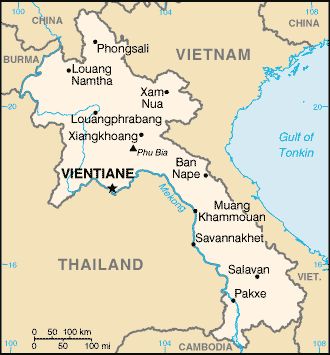|
LAOS
|
|
|
|
|
|
|
|
The Government of Laos, one of the few remaining one-party communist states, began decentralizing control and encouraging private enterprise in 1986. Economic growth averaged more than 6% per year from 1988-2008, and Laos' growth has more recently been amongst the fastest in Asia, averaging nearly 8% per year for most of the last decade, but has declined over the past year and is expected to be around 6.8% in 2017, according to the IMF.
Nevertheless, Laos remains a country with an underdeveloped infrastructure, particularly in rural areas. It has a basic, but improving, road system, and limited external and internal land-line telecommunications. Electricity is available to 83% of the population. Agriculture, dominated by rice cultivation in lowland areas, accounts for about 25% of GDP and 73% of total employment. Recently, the country has faced a persistent current account deficit, falling foreign currency reserves, and growing public debt, as slow recovery of the global economy, especially that of China, has driven down the prices of its mineral exports.
Laos' economy is heavily dependent on capital-intensive natural resource exports. The economy has benefited from high-profile foreign direct investment in hydropower dams along the Mekong River, copper and gold mining, logging, and construction; although some projects in these industries have drawn criticism for their environmental impacts.
Laos held the chairmanship of ASEAN in 2016. Laos is in the process of implementing a value-added tax system. The government appears committed to raising the country's profile among foreign investors and has developed special economic zones replete with generous tax incentives, but a limited labor pool, a small domestic market, and corruption remain impediments to investment. Laos also has ongoing problems with the business environment, including onerous registration requirements, a gap between legislation and implementation, and unclear or conflicting regulations.
At a glance
|
Country Name
|
Lao People’s Democratic Republic
|
|
Area
|
236,800 sq.km
|
|
Capital
|
Vientiane
|
|
Government type
|
Communist state
|
|
Administrative divisions
|
17 provinces (khoueng, singular and plural) and 1 capital city* (nakhon luang, singular and plural); Attapu, Bokeo, Bolikhamxai, Champasak, Houaphan, Khammouan, Louangnamtha, Louangphabang, Oudomxai, Phongsali, Salavan, Savannakhet, Viangchan (Vientiane)*, Viangchan, Xaignabouli, Xaisomboun, Xekong, Xiangkhouang
|
|
National Holidays
|
Republic Day- 2nd December
|
|
Fiscal year
|
1st October – 30th September
|
|
Currency
|
Kip (LAK)
|
|
President
|
Mr. BOUNNYANG Vorachit (since 20th April 2016)
|
|
Prime Minister
|
Mr.THONGLOUN Sisoulit (since 20th April 2016)
|
|
Population
|
7,126,706 (July 2017 est.)
|
|
Net migration rate
|
-1.1 migrant(s)/1,000 population (2017 est.)
|
|
GDP (purchasing power parity)
|
$40.9 billion (2016 est.)
|
|
GDP- composition by sector
|
Agriculture: 21.3%
Industry: 32.5 %
Services: 39.4% (2015 est.)
|
|
Agriculture- Products
|
Sweet potatoes, vegetables, corn, coffee, sugarcane, tobacco, cotton, tea, peanuts, rice; cassava (manioc), water buffalo, pigs, cattle, poultry
|
|
Industries
|
Mining (copper, tin, gold, and gypsum); timber, electric power, agricultural processing, rubber, construction, garments, cement, tourism
|
|
Major Exports
|
Wood products, coffee, electricity, tin, copper, gold, cassava
|
|
Major Exports - Partners
|
Thailand 30.4%, China 27%, Vietnam 17.5% (2015)
|
|
Major Imports
|
Machinery and equipment, vehicles, fuel, consumer goods
|
|
Major Importers Partners
|
Thailand 60.9%, China 18.6%, Vietnam 7.3% (2015)
|
|
Natural resources
|
Timber, hydropower, gypsum, tin, gold, gemstones
|
|
Languages
|
Lao (official), French, English, various ethnic languages
|
|
Ethnic groups
|
Lao 53.2%, Khmou 11%, Hmong 9.2%, Phouthay 3.4%, Tai 3.1%, Makong 2.5%, Katong 2.2%, Lue 2%, Akha 1.8%, other 11.6% (2015 est)
|
|
Climate
|
Tropical monsoon; rainy season (May to November); Dry season (December to April)
|
|
Location
|
Southeastern Asia, northeast of Thailand, west of Vietnam |

